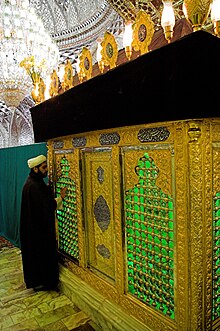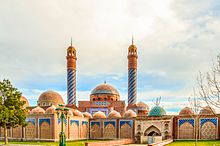An imamzadeh (Persian: امامزاده, romanized: emāmzādeh) is a Persian term with two related meanings: a type of holy person in Shia Islam, and the shrine-tomb of such a person.
Firstly, it means an immediate descendant of a Shi'i Imam. The term is also used in Urdu and Azeri. Imamzadeh means "offspring" or descendant of an imam. There are many different ways of spelling the word in English, such as imamzada, imamzadah and emamzadah. Imamzadeh are basically the Syed's or Syeda's as they have descended from the Imams. Imamzadehs are also sayyids, though not all sayyids are considered imamzadehs.
There are many important imamzadehs. Two of these are Fātimah bint Mūsā, the sister of Imam Ali al-Ridha, the eighth Twelver Imam, and Zaynab bint Ali, daughter of Ali, considered by Shi'i Muslims to be the first Imam and by Sunni Muslims as the fourth Rashid. Imamzadehs are not traditionally women.
Secondly, imamzadeh is a term for a shrine-tomb of the descendants of Imams, who are directly related to Muhammad. These shrines are only for the descendants of Imams and they are not for the Imams themselves. These shrine-tombs are used as centers of Shi'i devotion and pilgrimages. They are believed to have miraculous properties and the ability to heal. Many of them are located in Iraq, Medina, India and Iran.



Many people visit the imamzadehs that are relatively close to them. There are also special ziyarat-namas (pilgrimages) for many of the imamzadehs. Some of these pilgrimages even happen annually during the certain time of year. Some of the imamzadehs are not as well kept as others. According to Reinisch, an imamzadeh that he saw was mostly in ruins, though it is still important.
List of Imamzadeh shrine-tombs
- Imamzadeh Hamzah, Tabriz
- Imamzadeh Hamzeh, Kashmar
- Imamzadeh Ja'far, Borujerd
- Imamzadeh Ja'far, Damghan
- Imamzadeh Ja'far, Isfahan
- Imamzadeh Saleh, Shemiran
- Imamzadeh Sultan Mutahhar
- Imamzadeh (Ganja)
- Imamzadeh Ahmad
- Imamzadeh Esmaeil and Isaiah mausoleum
- Imamzadeh Haroun-e-Velayat
- Imamzadeh Mohammad
- Imamzadeh Seyed Morteza
- Imamzadeh Shah Zeyd
- Imamzade Hossein, Qazvin
- Shah-Abdol-Azim shrine
- Shah Cheragh
- Tomb of Ali ibn Hamzah, Shiraz
- Tomb of Seyed Alaeddin Husayn
Popular culture
The Imamzadehs were so influential that some cities or parts of cities are named after the Imamzadehs who are buried there, for example, Torbat-e Heydarieh, Astaneh-ye Ashrafiyeh in Gilan, Astaneh near Arak, and Shahreza.
See also
References
- ^ Esposito, John L. 2003. The Oxford Dictionary of Islam. Oxford University Press. Oxford. p 136.
- Glasse, Cyril. 2001. The Concise Encyclopedia of Islam. Revised Edition. Stacey International, London. p. 213
- ^ Lambton, A.K.S. "Imamzada." Encyclopedia of Islam, Second Edition. Edited by: P. Bearman, Th. Bianquis, C.E. Bosworth, E. Van Donzel and W.P. Heinrichs. Brill, 2010. Brill Online. Augustana. 6 April 2010 <http://www.brillonline.nl/subscriber/entry?entry=islam_SIM-3552>
- Esposito, John L. 1995. The Oxford Encyclopedia of the Modern Islamic World, v.2. Oxford University Press. Oxford. p. 185
- Reinisch, Leo (1897). "Egypt and Abyssinia". The Geographical Journal. 9 (3): 314–318. doi:10.2307/1774943. ISSN 0016-7398.
- Iran. Lonely Planet. 2013. p. 211. ISBN 978-8-8663-9974-2.
- Nic Dark. "Ali Ebn-e Hamze Mosque-Travel to Iran/". Iran Tourism Center. Archived from the original on 16 November 2016. Retrieved 15 November 2016.
- "loving Imomzadeh".
| Islamic architecture | ||||||||||||||||||||
|---|---|---|---|---|---|---|---|---|---|---|---|---|---|---|---|---|---|---|---|---|
| Styles | ||||||||||||||||||||
| Elements |
| |||||||||||||||||||
| Types |
| |||||||||||||||||||
| Resources | ||||||||||||||||||||
| Influences | ||||||||||||||||||||
| Category pages | ||||||||||||||||||||
| Part of Islamic arts • | ||||||||||||||||||||
| Iranian architecture | ||||||
|---|---|---|---|---|---|---|
| Periods |
|  | ||||
| Types | ||||||
| Elements | ||||||
| Traditional cities | ||||||
| Theory and analysis | ||||||
| Lists | ||||||
